
T. pisoliticola spikelet.
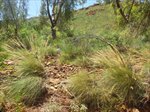
T. pisoliticola habitat.

T. pisoliticola orifice.
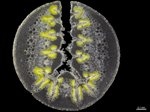
T. pisoliticola leaf section.
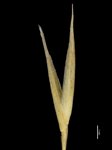
T. pisoliticola glumes.

T. pisoliticola lemmas.
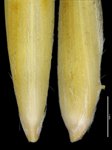
T. pisoliticola lemma bases.
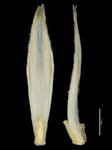
T. pisoliticola paleas.

T. pisoliticola map.
Name
Triodia pisoliticola Trudgen & M.D.Barrett, ined.
Citation
Nuytsia, in press, (2017).
Derivation
pisoliticola — from pisolite, a geological term for a conglomerate of pea-sized pieces such as gravel (in turn derived from Latin pisum, pea), and Latin –cola, dweller, in reference to its common occurrence on pisolite mesas.
Common name
Mesa Spinifex
Synonyms
Triodia sp. Robe River (M.E. Trudgen et al. MET 12367)
Diagnostic features
Foliage non-resinous; leaf sheath surfaces glabrous or hairy; leaf blades epistomatous (soft-type), 24–59 cm long and lax; spikelets with 0–2 reduced infertile florets at the apex; lower glume narrowly lanceolate, 3–5-nerved; lemmas awned; lowest lemma midlobe 4.2–9 mm long; palea glabrous; distribution in west Pilbara.
Habitat
Occurs on ironstone mesas, slopes and gullies, or sometimes on flat loam.
Distribution and frequency
Endemic to the west Pilbara, most abundant from Cane River to Pannawonica but with a few localized occurrences outside this area.
Similar species
Triodia pisoliticola belongs to the Soft group, sharing the epistomatous (soft-type) leaf blades. All other Pilbara species with epistomatous (soft-type) leaf blades and distinctly awned (not lobed or very shortly-awned) lemmas either have resinous foliage (always non-resinous in T. pisoliticola) or bitextured lemmas (uniformly textured at maturity in T. pisoliticola).
Triodia pisoliticola is similar to T. melvillei but has non-resinous, lax and usually drooping leaves 24–59 cm long [15–35(–46) mm long in T. melvillei], 0–2 reduced infertile florets terminating spikelets (3–4 reduced infertile florets at the apex of spikelets in T. melvillei), and occurs in the west Pilbara, disjunct from the distribution of T. melvillei.
The closest genetic relative of T. pisoliticola is T. karijini, which shares the narrowly lanceolate glumes and non-resinous, epistomatous leaves, but occurs disjunctly in the eastern Hamersley Range. Triodia karijini differs from T. pisoliticola in having narrowly triangular to sub-awned lemma lobes 2–3 mm long (distinctly awned and 4.2–9 mm long in T. pisoliticola) and generally shorter leaves 19–34 cm long (24–59 cm long in T. pisoliticola).
Triodia avenoides, T. basitricha, T. degreyensis, T. schinzii, and T. sp. Mt Ella all have bitextured lemmas (uniformly textured in T. pisoliticola) and hairs uniformly distributed over the surface of the lemma (where present in longitudinal rows in T. pisoliticola).
T. veniciae has resinous foliage (non-resinous in T. pisoliticola), lemma lobes narrowly acute to sub-awned (distinctly awned in T. pisoliticola), and occurs in the Chichester sub-region (Hamersley, Gascoyne or Little Sandy Desert regions for T. melvillei).
Conservation status
Priority Three.
Identification without florets
The epistomatous (soft-type) leaves, non-resinous foliage and west Pilbara distribution is a combination shared only with Triodia basitricha, which also shares the narrowly lanceolate glumes. The two species differ in leaf blade length (24–59 cm long in T. pisoliticola, 13–25 cm long in T. basitricha).
Variation
Leaf sheaths can be hairy or glabrous on surfaces.
Notes
Triodia pisoliticola was included under a broad concept of T. melvillei by Lazarides (1997), Lazarides et al. (2005) and Ausgrass (Sharp & Simon, 2002; Simon & Alonso, 2014), but was noted as a non-resinous variant.
A full description of T. pisoliticola can be found in Barrett & Trudgen (2017b).